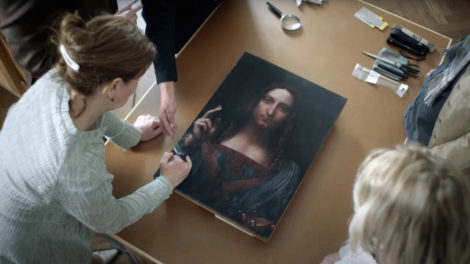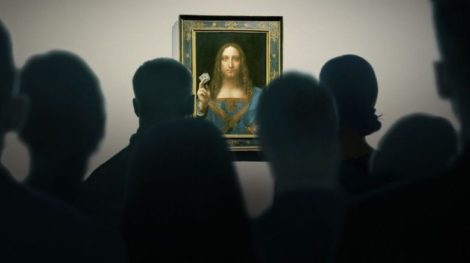The Lost Leonardo
Tropic Sprockets by Ian Brockway
[mr_rating_result]“The Lost Leonardo,” a new documentary by Andreas Koefoed (“Ballroom Dancer”) underscores the dilemma of the controversial Salvator Mundi, a portrait of Christ validated by some noted scholars to have been painted by Da Vinci.
 The documentary is brisk and compelling, moving across the screen like a breakneck chase.
The documentary is brisk and compelling, moving across the screen like a breakneck chase.
The original painting by Da Vinci is predominantly thought to have been lost in 1603. In 2005, the then unknown painting was presented in New Orleans and sold at auction for around eleven hundred dollars. It was severely overpainted and could not be validated as a Da Vinci in any form. It was thought to be a copy or possibly a work by a follower of the master.
The dealers Alexander Parrish and Robert Simon believed that the work could possibly be a lost Leonardo, a mythical Salvator Mundi.
Dianne Modestini from NYU was brought in to look at the work and oversee the restoration. When Modestini applied an acetone solution to erase the botched overpainting and varnish, she was aghast, the placement of the thumb and its correction, pointed to the very real possibility that the painting was, in fact, executed by Da Vinci himself. Further, when Modestini compared the painting to the Mona Lisa she was struck by the same haunting vanishing lines of the upper and lower lip. Modestini was utterly convinced: no one but the master could have done the Salvator Mundi. Soon after, the painting was generally validated by many experts to be authentic, albeit not overwhelmingly.
The painting was exhibited to huge crowds. Many spectators were caught spellbound as if in a religious ecstasy, including actor Leonardo DiCaprio whose eyes watered on site.
 The film then shifts into the world of money and manipulation. In May 2013, art dealer Yves Bouvier purchases the painting for almost eighty million. Thereafter, the work is sold to a Russian billionaire Dimitry Rybolovlev, for $127.5 million. In 2017 the painting was auctioned at Christie’s for $450 million. The buyer was ultimately revealed to be Prince Salman of Saudi Arabia.
The film then shifts into the world of money and manipulation. In May 2013, art dealer Yves Bouvier purchases the painting for almost eighty million. Thereafter, the work is sold to a Russian billionaire Dimitry Rybolovlev, for $127.5 million. In 2017 the painting was auctioned at Christie’s for $450 million. The buyer was ultimately revealed to be Prince Salman of Saudi Arabia.
Most haunting is the art restorer Dianne Modestini who clearly loves the painting, believing it to be genuine. She is haunted by the work and laments it being bought and sold being hidden away like a God, becoming ambrosia for the rich and powerful.
Despite the stunning acquisition by Saudi Arabia, there are those who say it is not by any stretch of the imagination a genuine work. Dealer Kenny Schachter says the painting is cheaply made, pointing to the wooden knot in the piece that caused the painting to crack. According to Schachter, Da Vinci never worked with inexpensive materials and would never tolerate any shoddiness, wooden or otherwise.
Critic Jerry Saltz judges the painting not “good” regardless of who the artist may be.
Currently the painting’s location is not known.
The Louvre supposedly published a mythical catalogue of the painting, yet Louvre representatives have said that no such book exists. An exhibition was planned, yet the painting did not appear.
Perhaps the painting is locked in a vault, placed in a Siberian safe house or well ensconced in a desert oasis. No one knows for certain.
Whatever the case, “The Lost Leonardo” is a painterly thriller of the cat and mouse kind. It is as much a meditation of desire, money and the power of belief, as it is about the hand of Da Vinci and two supernaturally revolving fingers.
Write Ian at ianfree11@yahoo.com


Ratings & Comments
[mr_rating_form]